Pharmacology: Mechanism of Action and Pharmacokinetics of Cannabinoids
VerifiedAdded on 2023/06/15
|8
|1841
|88
AI Summary
This article discusses the mechanism of action and pharmacokinetics of cannabinoids both as therapeutic and recreational drugs. It explores the routes of administration, pharmacokinetics, pharmacodynamics, and side effects of the drug.
Contribute Materials
Your contribution can guide someone’s learning journey. Share your
documents today.
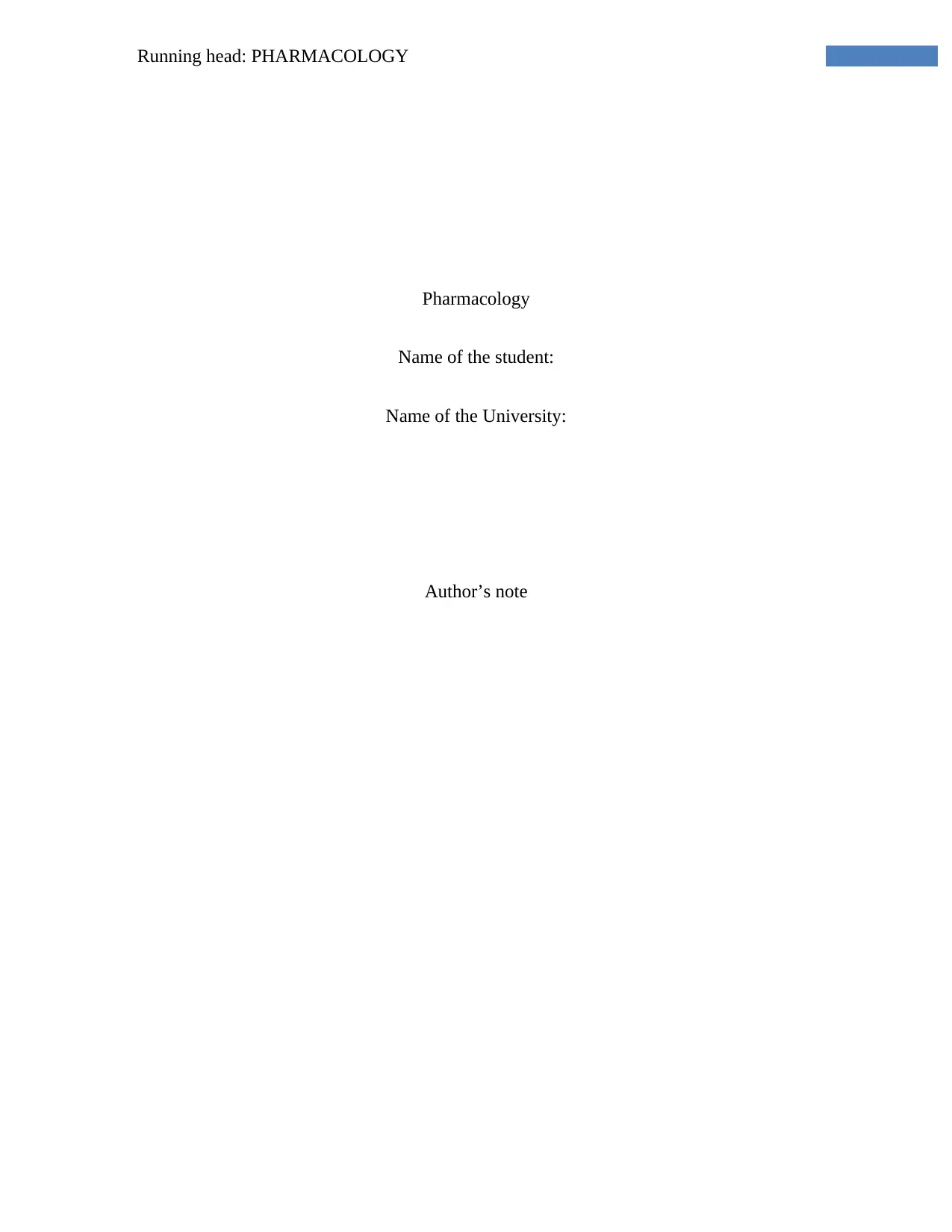
Running head: PHARMACOLOGY
Pharmacology
Name of the student:
Name of the University:
Author’s note
Pharmacology
Name of the student:
Name of the University:
Author’s note
Secure Best Marks with AI Grader
Need help grading? Try our AI Grader for instant feedback on your assignments.
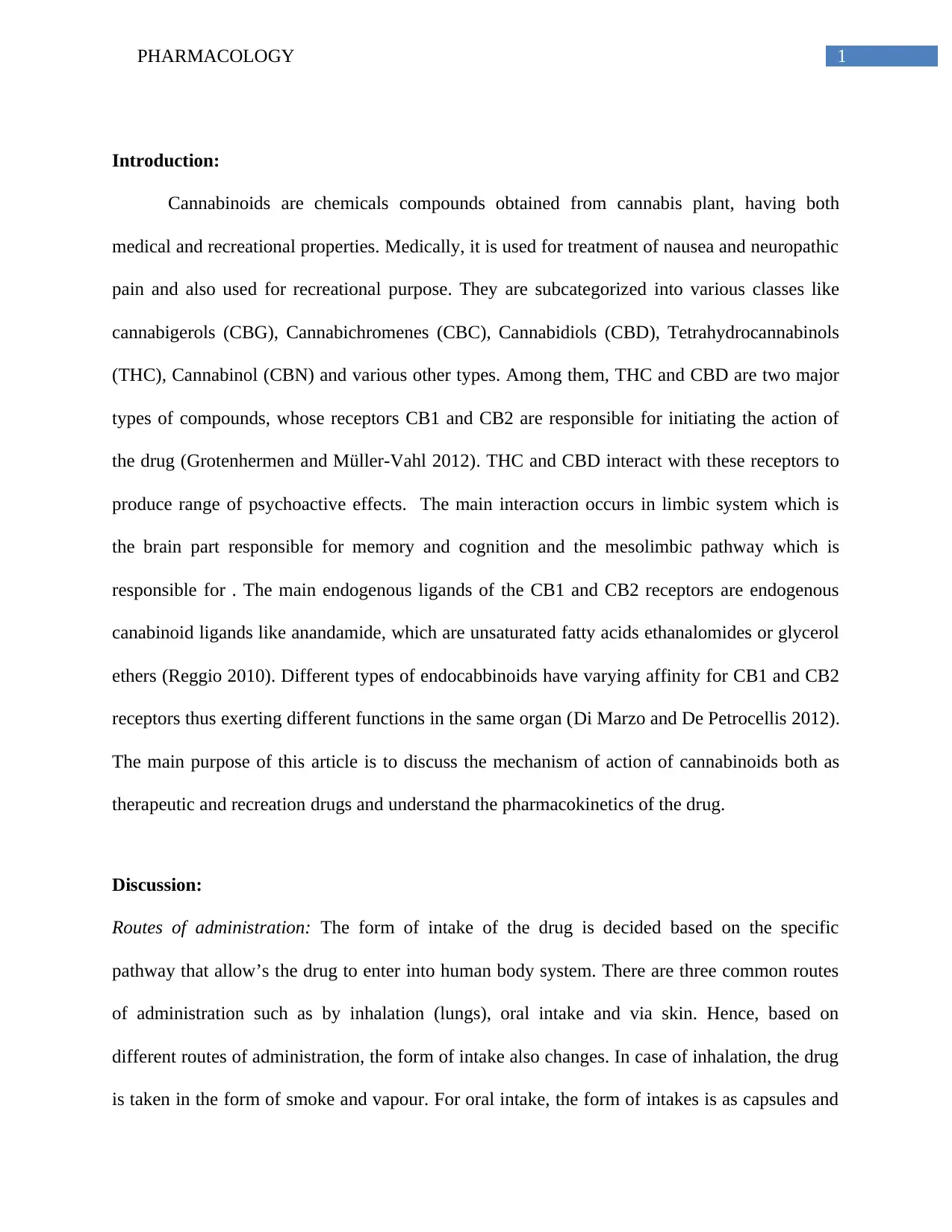
1PHARMACOLOGY
Introduction:
Cannabinoids are chemicals compounds obtained from cannabis plant, having both
medical and recreational properties. Medically, it is used for treatment of nausea and neuropathic
pain and also used for recreational purpose. They are subcategorized into various classes like
cannabigerols (CBG), Cannabichromenes (CBC), Cannabidiols (CBD), Tetrahydrocannabinols
(THC), Cannabinol (CBN) and various other types. Among them, THC and CBD are two major
types of compounds, whose receptors CB1 and CB2 are responsible for initiating the action of
the drug (Grotenhermen and Müller-Vahl 2012). THC and CBD interact with these receptors to
produce range of psychoactive effects. The main interaction occurs in limbic system which is
the brain part responsible for memory and cognition and the mesolimbic pathway which is
responsible for . The main endogenous ligands of the CB1 and CB2 receptors are endogenous
canabinoid ligands like anandamide, which are unsaturated fatty acids ethanalomides or glycerol
ethers (Reggio 2010). Different types of endocabbinoids have varying affinity for CB1 and CB2
receptors thus exerting different functions in the same organ (Di Marzo and De Petrocellis 2012).
The main purpose of this article is to discuss the mechanism of action of cannabinoids both as
therapeutic and recreation drugs and understand the pharmacokinetics of the drug.
Discussion:
Routes of administration: The form of intake of the drug is decided based on the specific
pathway that allow’s the drug to enter into human body system. There are three common routes
of administration such as by inhalation (lungs), oral intake and via skin. Hence, based on
different routes of administration, the form of intake also changes. In case of inhalation, the drug
is taken in the form of smoke and vapour. For oral intake, the form of intakes is as capsules and
Introduction:
Cannabinoids are chemicals compounds obtained from cannabis plant, having both
medical and recreational properties. Medically, it is used for treatment of nausea and neuropathic
pain and also used for recreational purpose. They are subcategorized into various classes like
cannabigerols (CBG), Cannabichromenes (CBC), Cannabidiols (CBD), Tetrahydrocannabinols
(THC), Cannabinol (CBN) and various other types. Among them, THC and CBD are two major
types of compounds, whose receptors CB1 and CB2 are responsible for initiating the action of
the drug (Grotenhermen and Müller-Vahl 2012). THC and CBD interact with these receptors to
produce range of psychoactive effects. The main interaction occurs in limbic system which is
the brain part responsible for memory and cognition and the mesolimbic pathway which is
responsible for . The main endogenous ligands of the CB1 and CB2 receptors are endogenous
canabinoid ligands like anandamide, which are unsaturated fatty acids ethanalomides or glycerol
ethers (Reggio 2010). Different types of endocabbinoids have varying affinity for CB1 and CB2
receptors thus exerting different functions in the same organ (Di Marzo and De Petrocellis 2012).
The main purpose of this article is to discuss the mechanism of action of cannabinoids both as
therapeutic and recreation drugs and understand the pharmacokinetics of the drug.
Discussion:
Routes of administration: The form of intake of the drug is decided based on the specific
pathway that allow’s the drug to enter into human body system. There are three common routes
of administration such as by inhalation (lungs), oral intake and via skin. Hence, based on
different routes of administration, the form of intake also changes. In case of inhalation, the drug
is taken in the form of smoke and vapour. For oral intake, the form of intakes is as capsules and
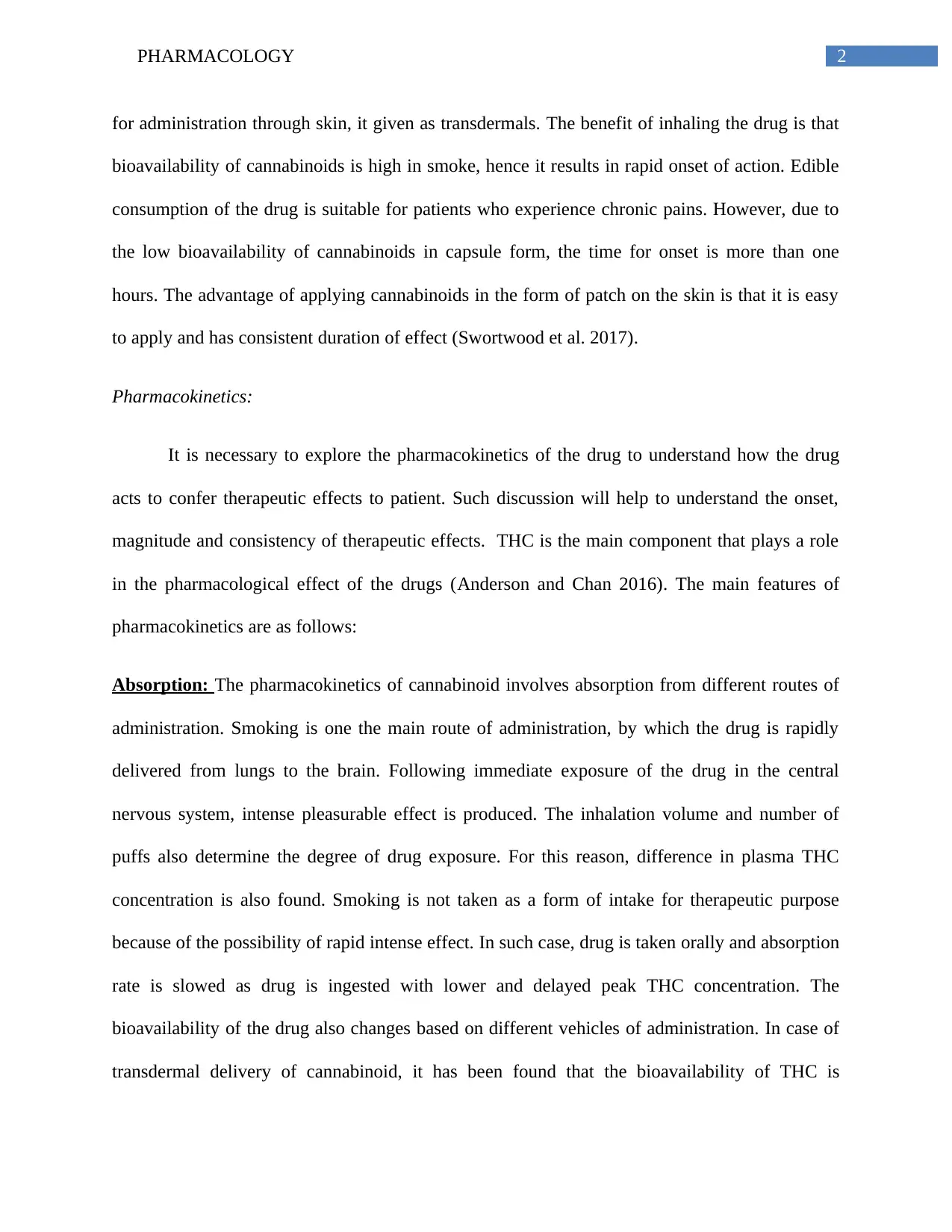
2PHARMACOLOGY
for administration through skin, it given as transdermals. The benefit of inhaling the drug is that
bioavailability of cannabinoids is high in smoke, hence it results in rapid onset of action. Edible
consumption of the drug is suitable for patients who experience chronic pains. However, due to
the low bioavailability of cannabinoids in capsule form, the time for onset is more than one
hours. The advantage of applying cannabinoids in the form of patch on the skin is that it is easy
to apply and has consistent duration of effect (Swortwood et al. 2017).
Pharmacokinetics:
It is necessary to explore the pharmacokinetics of the drug to understand how the drug
acts to confer therapeutic effects to patient. Such discussion will help to understand the onset,
magnitude and consistency of therapeutic effects. THC is the main component that plays a role
in the pharmacological effect of the drugs (Anderson and Chan 2016). The main features of
pharmacokinetics are as follows:
Absorption: The pharmacokinetics of cannabinoid involves absorption from different routes of
administration. Smoking is one the main route of administration, by which the drug is rapidly
delivered from lungs to the brain. Following immediate exposure of the drug in the central
nervous system, intense pleasurable effect is produced. The inhalation volume and number of
puffs also determine the degree of drug exposure. For this reason, difference in plasma THC
concentration is also found. Smoking is not taken as a form of intake for therapeutic purpose
because of the possibility of rapid intense effect. In such case, drug is taken orally and absorption
rate is slowed as drug is ingested with lower and delayed peak THC concentration. The
bioavailability of the drug also changes based on different vehicles of administration. In case of
transdermal delivery of cannabinoid, it has been found that the bioavailability of THC is
for administration through skin, it given as transdermals. The benefit of inhaling the drug is that
bioavailability of cannabinoids is high in smoke, hence it results in rapid onset of action. Edible
consumption of the drug is suitable for patients who experience chronic pains. However, due to
the low bioavailability of cannabinoids in capsule form, the time for onset is more than one
hours. The advantage of applying cannabinoids in the form of patch on the skin is that it is easy
to apply and has consistent duration of effect (Swortwood et al. 2017).
Pharmacokinetics:
It is necessary to explore the pharmacokinetics of the drug to understand how the drug
acts to confer therapeutic effects to patient. Such discussion will help to understand the onset,
magnitude and consistency of therapeutic effects. THC is the main component that plays a role
in the pharmacological effect of the drugs (Anderson and Chan 2016). The main features of
pharmacokinetics are as follows:
Absorption: The pharmacokinetics of cannabinoid involves absorption from different routes of
administration. Smoking is one the main route of administration, by which the drug is rapidly
delivered from lungs to the brain. Following immediate exposure of the drug in the central
nervous system, intense pleasurable effect is produced. The inhalation volume and number of
puffs also determine the degree of drug exposure. For this reason, difference in plasma THC
concentration is also found. Smoking is not taken as a form of intake for therapeutic purpose
because of the possibility of rapid intense effect. In such case, drug is taken orally and absorption
rate is slowed as drug is ingested with lower and delayed peak THC concentration. The
bioavailability of the drug also changes based on different vehicles of administration. In case of
transdermal delivery of cannabinoid, it has been found that the bioavailability of THC is
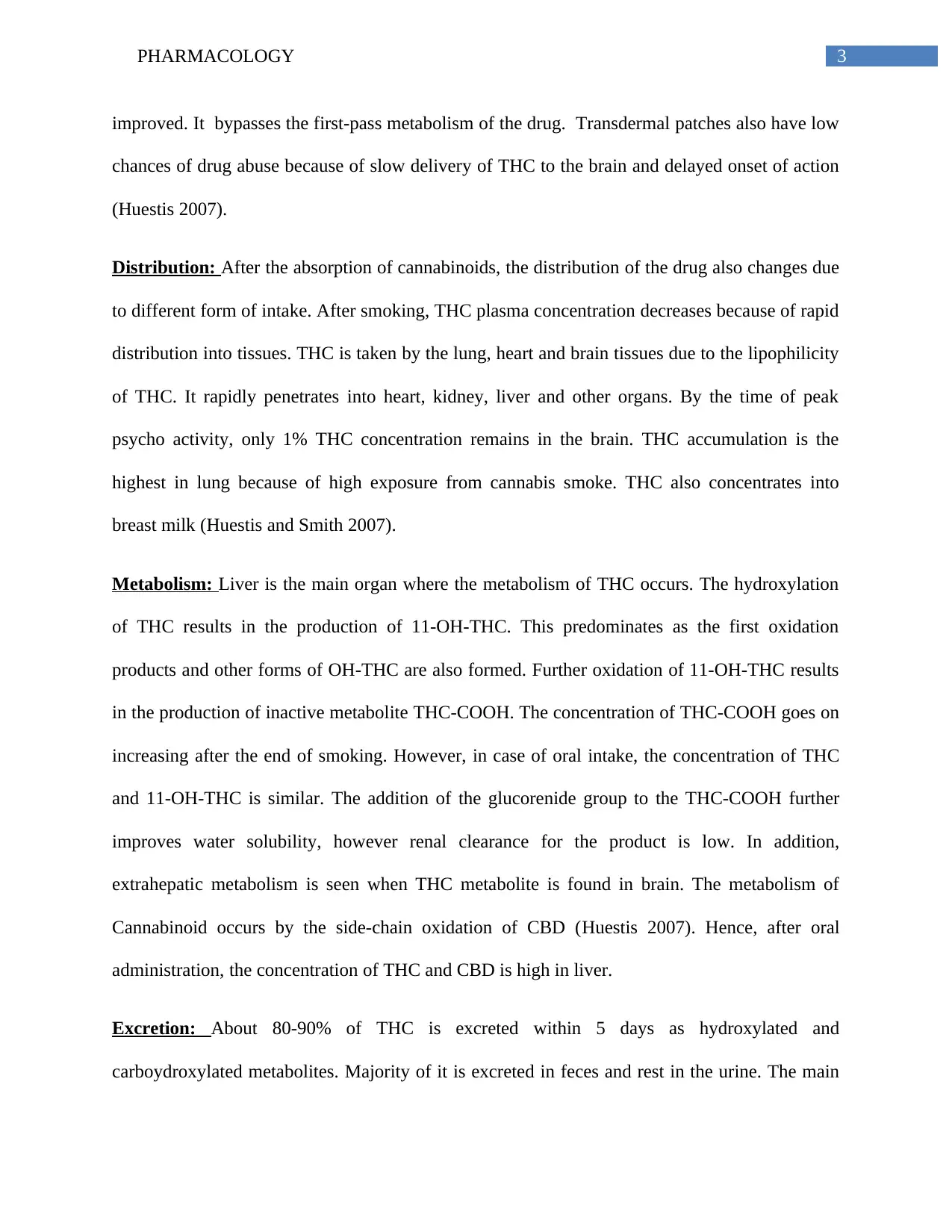
3PHARMACOLOGY
improved. It bypasses the first-pass metabolism of the drug. Transdermal patches also have low
chances of drug abuse because of slow delivery of THC to the brain and delayed onset of action
(Huestis 2007).
Distribution: After the absorption of cannabinoids, the distribution of the drug also changes due
to different form of intake. After smoking, THC plasma concentration decreases because of rapid
distribution into tissues. THC is taken by the lung, heart and brain tissues due to the lipophilicity
of THC. It rapidly penetrates into heart, kidney, liver and other organs. By the time of peak
psycho activity, only 1% THC concentration remains in the brain. THC accumulation is the
highest in lung because of high exposure from cannabis smoke. THC also concentrates into
breast milk (Huestis and Smith 2007).
Metabolism: Liver is the main organ where the metabolism of THC occurs. The hydroxylation
of THC results in the production of 11-OH-THC. This predominates as the first oxidation
products and other forms of OH-THC are also formed. Further oxidation of 11-OH-THC results
in the production of inactive metabolite THC-COOH. The concentration of THC-COOH goes on
increasing after the end of smoking. However, in case of oral intake, the concentration of THC
and 11-OH-THC is similar. The addition of the glucorenide group to the THC-COOH further
improves water solubility, however renal clearance for the product is low. In addition,
extrahepatic metabolism is seen when THC metabolite is found in brain. The metabolism of
Cannabinoid occurs by the side-chain oxidation of CBD (Huestis 2007). Hence, after oral
administration, the concentration of THC and CBD is high in liver.
Excretion: About 80-90% of THC is excreted within 5 days as hydroxylated and
carboydroxylated metabolites. Majority of it is excreted in feces and rest in the urine. The main
improved. It bypasses the first-pass metabolism of the drug. Transdermal patches also have low
chances of drug abuse because of slow delivery of THC to the brain and delayed onset of action
(Huestis 2007).
Distribution: After the absorption of cannabinoids, the distribution of the drug also changes due
to different form of intake. After smoking, THC plasma concentration decreases because of rapid
distribution into tissues. THC is taken by the lung, heart and brain tissues due to the lipophilicity
of THC. It rapidly penetrates into heart, kidney, liver and other organs. By the time of peak
psycho activity, only 1% THC concentration remains in the brain. THC accumulation is the
highest in lung because of high exposure from cannabis smoke. THC also concentrates into
breast milk (Huestis and Smith 2007).
Metabolism: Liver is the main organ where the metabolism of THC occurs. The hydroxylation
of THC results in the production of 11-OH-THC. This predominates as the first oxidation
products and other forms of OH-THC are also formed. Further oxidation of 11-OH-THC results
in the production of inactive metabolite THC-COOH. The concentration of THC-COOH goes on
increasing after the end of smoking. However, in case of oral intake, the concentration of THC
and 11-OH-THC is similar. The addition of the glucorenide group to the THC-COOH further
improves water solubility, however renal clearance for the product is low. In addition,
extrahepatic metabolism is seen when THC metabolite is found in brain. The metabolism of
Cannabinoid occurs by the side-chain oxidation of CBD (Huestis 2007). Hence, after oral
administration, the concentration of THC and CBD is high in liver.
Excretion: About 80-90% of THC is excreted within 5 days as hydroxylated and
carboydroxylated metabolites. Majority of it is excreted in feces and rest in the urine. The main
Secure Best Marks with AI Grader
Need help grading? Try our AI Grader for instant feedback on your assignments.
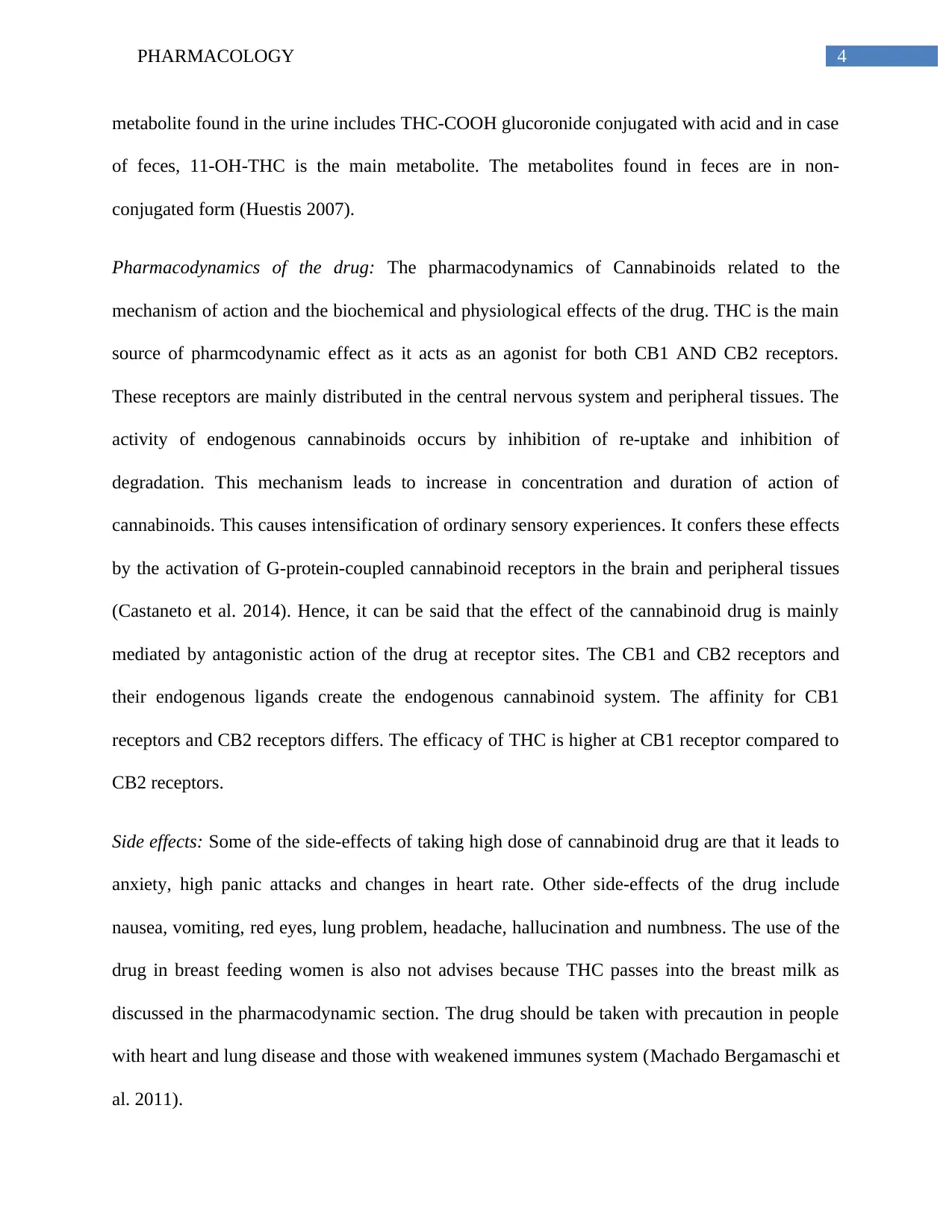
4PHARMACOLOGY
metabolite found in the urine includes THC-COOH glucoronide conjugated with acid and in case
of feces, 11-OH-THC is the main metabolite. The metabolites found in feces are in non-
conjugated form (Huestis 2007).
Pharmacodynamics of the drug: The pharmacodynamics of Cannabinoids related to the
mechanism of action and the biochemical and physiological effects of the drug. THC is the main
source of pharmcodynamic effect as it acts as an agonist for both CB1 AND CB2 receptors.
These receptors are mainly distributed in the central nervous system and peripheral tissues. The
activity of endogenous cannabinoids occurs by inhibition of re-uptake and inhibition of
degradation. This mechanism leads to increase in concentration and duration of action of
cannabinoids. This causes intensification of ordinary sensory experiences. It confers these effects
by the activation of G-protein-coupled cannabinoid receptors in the brain and peripheral tissues
(Castaneto et al. 2014). Hence, it can be said that the effect of the cannabinoid drug is mainly
mediated by antagonistic action of the drug at receptor sites. The CB1 and CB2 receptors and
their endogenous ligands create the endogenous cannabinoid system. The affinity for CB1
receptors and CB2 receptors differs. The efficacy of THC is higher at CB1 receptor compared to
CB2 receptors.
Side effects: Some of the side-effects of taking high dose of cannabinoid drug are that it leads to
anxiety, high panic attacks and changes in heart rate. Other side-effects of the drug include
nausea, vomiting, red eyes, lung problem, headache, hallucination and numbness. The use of the
drug in breast feeding women is also not advises because THC passes into the breast milk as
discussed in the pharmacodynamic section. The drug should be taken with precaution in people
with heart and lung disease and those with weakened immunes system (Machado Bergamaschi et
al. 2011).
metabolite found in the urine includes THC-COOH glucoronide conjugated with acid and in case
of feces, 11-OH-THC is the main metabolite. The metabolites found in feces are in non-
conjugated form (Huestis 2007).
Pharmacodynamics of the drug: The pharmacodynamics of Cannabinoids related to the
mechanism of action and the biochemical and physiological effects of the drug. THC is the main
source of pharmcodynamic effect as it acts as an agonist for both CB1 AND CB2 receptors.
These receptors are mainly distributed in the central nervous system and peripheral tissues. The
activity of endogenous cannabinoids occurs by inhibition of re-uptake and inhibition of
degradation. This mechanism leads to increase in concentration and duration of action of
cannabinoids. This causes intensification of ordinary sensory experiences. It confers these effects
by the activation of G-protein-coupled cannabinoid receptors in the brain and peripheral tissues
(Castaneto et al. 2014). Hence, it can be said that the effect of the cannabinoid drug is mainly
mediated by antagonistic action of the drug at receptor sites. The CB1 and CB2 receptors and
their endogenous ligands create the endogenous cannabinoid system. The affinity for CB1
receptors and CB2 receptors differs. The efficacy of THC is higher at CB1 receptor compared to
CB2 receptors.
Side effects: Some of the side-effects of taking high dose of cannabinoid drug are that it leads to
anxiety, high panic attacks and changes in heart rate. Other side-effects of the drug include
nausea, vomiting, red eyes, lung problem, headache, hallucination and numbness. The use of the
drug in breast feeding women is also not advises because THC passes into the breast milk as
discussed in the pharmacodynamic section. The drug should be taken with precaution in people
with heart and lung disease and those with weakened immunes system (Machado Bergamaschi et
al. 2011).
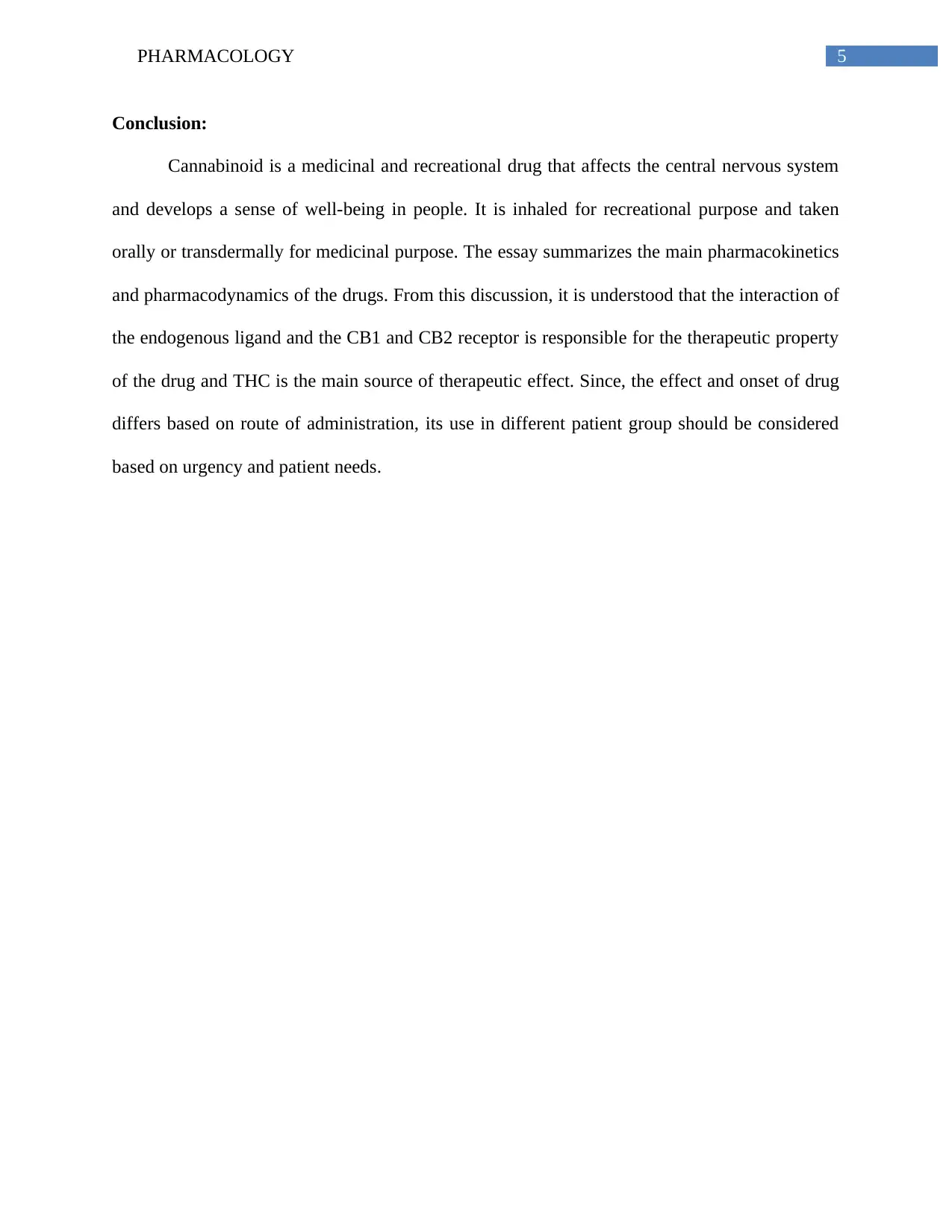
5PHARMACOLOGY
Conclusion:
Cannabinoid is a medicinal and recreational drug that affects the central nervous system
and develops a sense of well-being in people. It is inhaled for recreational purpose and taken
orally or transdermally for medicinal purpose. The essay summarizes the main pharmacokinetics
and pharmacodynamics of the drugs. From this discussion, it is understood that the interaction of
the endogenous ligand and the CB1 and CB2 receptor is responsible for the therapeutic property
of the drug and THC is the main source of therapeutic effect. Since, the effect and onset of drug
differs based on route of administration, its use in different patient group should be considered
based on urgency and patient needs.
Conclusion:
Cannabinoid is a medicinal and recreational drug that affects the central nervous system
and develops a sense of well-being in people. It is inhaled for recreational purpose and taken
orally or transdermally for medicinal purpose. The essay summarizes the main pharmacokinetics
and pharmacodynamics of the drugs. From this discussion, it is understood that the interaction of
the endogenous ligand and the CB1 and CB2 receptor is responsible for the therapeutic property
of the drug and THC is the main source of therapeutic effect. Since, the effect and onset of drug
differs based on route of administration, its use in different patient group should be considered
based on urgency and patient needs.
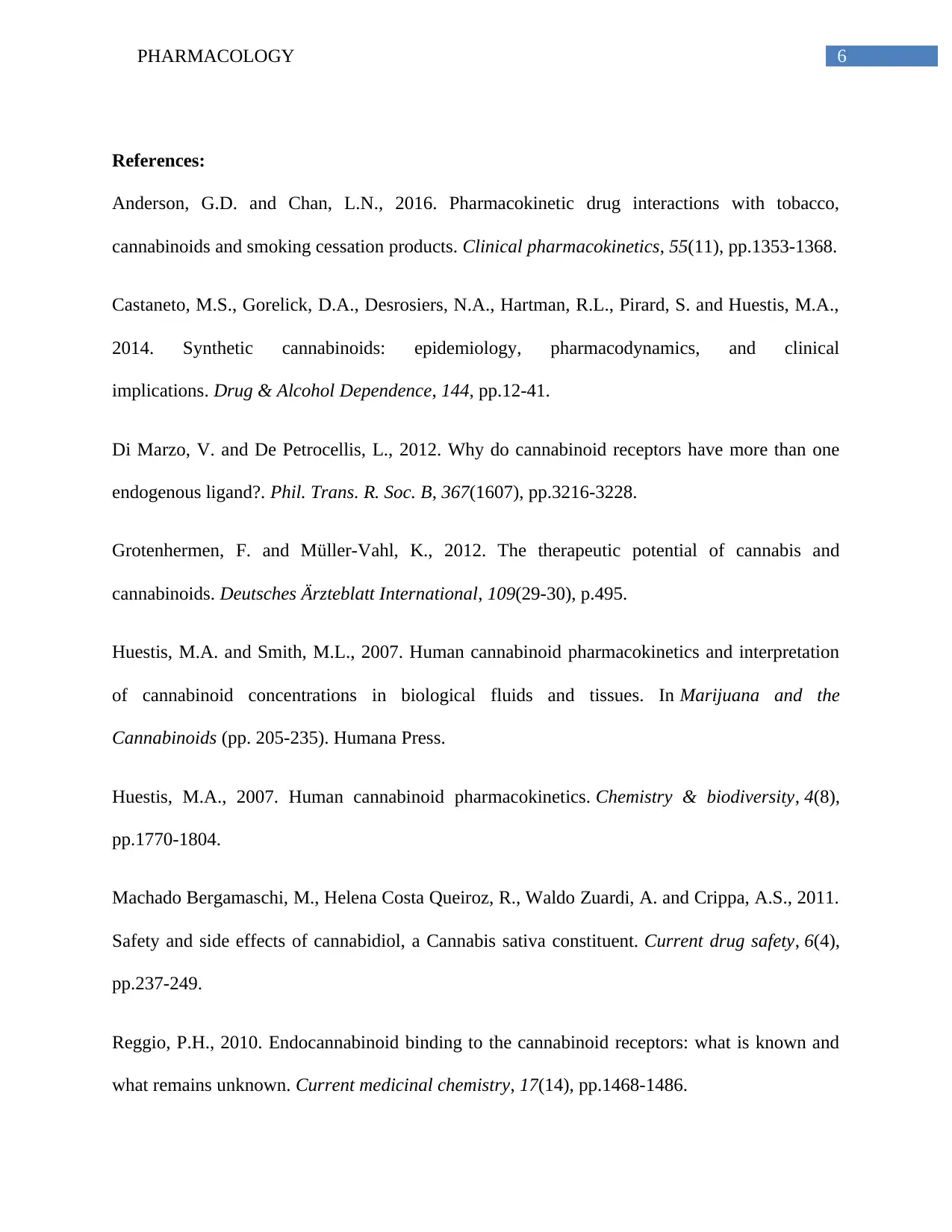
6PHARMACOLOGY
References:
Anderson, G.D. and Chan, L.N., 2016. Pharmacokinetic drug interactions with tobacco,
cannabinoids and smoking cessation products. Clinical pharmacokinetics, 55(11), pp.1353-1368.
Castaneto, M.S., Gorelick, D.A., Desrosiers, N.A., Hartman, R.L., Pirard, S. and Huestis, M.A.,
2014. Synthetic cannabinoids: epidemiology, pharmacodynamics, and clinical
implications. Drug & Alcohol Dependence, 144, pp.12-41.
Di Marzo, V. and De Petrocellis, L., 2012. Why do cannabinoid receptors have more than one
endogenous ligand?. Phil. Trans. R. Soc. B, 367(1607), pp.3216-3228.
Grotenhermen, F. and Müller-Vahl, K., 2012. The therapeutic potential of cannabis and
cannabinoids. Deutsches Ärzteblatt International, 109(29-30), p.495.
Huestis, M.A. and Smith, M.L., 2007. Human cannabinoid pharmacokinetics and interpretation
of cannabinoid concentrations in biological fluids and tissues. In Marijuana and the
Cannabinoids (pp. 205-235). Humana Press.
Huestis, M.A., 2007. Human cannabinoid pharmacokinetics. Chemistry & biodiversity, 4(8),
pp.1770-1804.
Machado Bergamaschi, M., Helena Costa Queiroz, R., Waldo Zuardi, A. and Crippa, A.S., 2011.
Safety and side effects of cannabidiol, a Cannabis sativa constituent. Current drug safety, 6(4),
pp.237-249.
Reggio, P.H., 2010. Endocannabinoid binding to the cannabinoid receptors: what is known and
what remains unknown. Current medicinal chemistry, 17(14), pp.1468-1486.
References:
Anderson, G.D. and Chan, L.N., 2016. Pharmacokinetic drug interactions with tobacco,
cannabinoids and smoking cessation products. Clinical pharmacokinetics, 55(11), pp.1353-1368.
Castaneto, M.S., Gorelick, D.A., Desrosiers, N.A., Hartman, R.L., Pirard, S. and Huestis, M.A.,
2014. Synthetic cannabinoids: epidemiology, pharmacodynamics, and clinical
implications. Drug & Alcohol Dependence, 144, pp.12-41.
Di Marzo, V. and De Petrocellis, L., 2012. Why do cannabinoid receptors have more than one
endogenous ligand?. Phil. Trans. R. Soc. B, 367(1607), pp.3216-3228.
Grotenhermen, F. and Müller-Vahl, K., 2012. The therapeutic potential of cannabis and
cannabinoids. Deutsches Ärzteblatt International, 109(29-30), p.495.
Huestis, M.A. and Smith, M.L., 2007. Human cannabinoid pharmacokinetics and interpretation
of cannabinoid concentrations in biological fluids and tissues. In Marijuana and the
Cannabinoids (pp. 205-235). Humana Press.
Huestis, M.A., 2007. Human cannabinoid pharmacokinetics. Chemistry & biodiversity, 4(8),
pp.1770-1804.
Machado Bergamaschi, M., Helena Costa Queiroz, R., Waldo Zuardi, A. and Crippa, A.S., 2011.
Safety and side effects of cannabidiol, a Cannabis sativa constituent. Current drug safety, 6(4),
pp.237-249.
Reggio, P.H., 2010. Endocannabinoid binding to the cannabinoid receptors: what is known and
what remains unknown. Current medicinal chemistry, 17(14), pp.1468-1486.
Paraphrase This Document
Need a fresh take? Get an instant paraphrase of this document with our AI Paraphraser
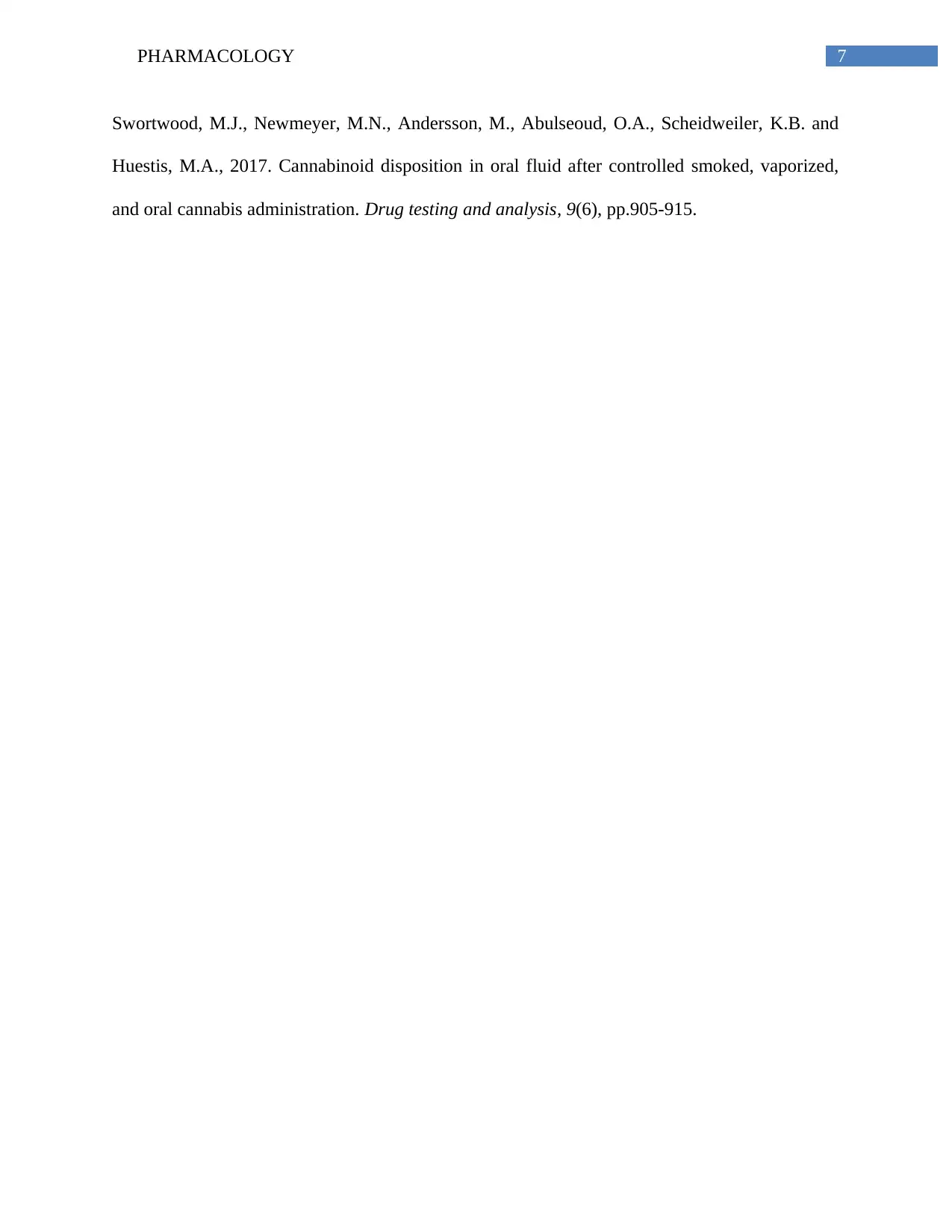
7PHARMACOLOGY
Swortwood, M.J., Newmeyer, M.N., Andersson, M., Abulseoud, O.A., Scheidweiler, K.B. and
Huestis, M.A., 2017. Cannabinoid disposition in oral fluid after controlled smoked, vaporized,
and oral cannabis administration. Drug testing and analysis, 9(6), pp.905-915.
Swortwood, M.J., Newmeyer, M.N., Andersson, M., Abulseoud, O.A., Scheidweiler, K.B. and
Huestis, M.A., 2017. Cannabinoid disposition in oral fluid after controlled smoked, vaporized,
and oral cannabis administration. Drug testing and analysis, 9(6), pp.905-915.
1 out of 8
Your All-in-One AI-Powered Toolkit for Academic Success.
+13062052269
info@desklib.com
Available 24*7 on WhatsApp / Email
![[object Object]](/_next/static/media/star-bottom.7253800d.svg)
Unlock your academic potential
© 2024 | Zucol Services PVT LTD | All rights reserved.
